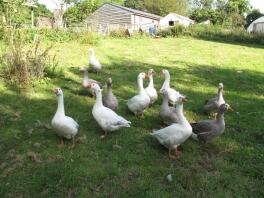Pilgrim Geese
Pilgrim History
What is certain is that the breed was derived from the “Common Goose” and the most significant thing about these is that the male is white and the female is grey. These very definite different colours in male and female are known as “auto-sexing” and this was much valued by poultry farmers mid 19th century as they could easily distinguish the sex of the birds at a comparatively early age. They are not plentiful in the UK but were taken up by some poultry exhibitors and so became better known.
Their purpose has always been as a medium-sized table bird that fattens well from grass – very typical of a goose that was probably raised on common land throughout the UK from medieval times.
Pilgrim Behaviour
Appearance
The gander (male) is primarily white, with a gray rump (usually obscured by feathers) and trace amount of gray interspersed throughout the wings. Geese (female) are dove gray with varying amounts of white on their faces. The white markings on the goose increase with age. Ganders have blue eyes, while geese have hazel-brown eyes. Both sexes have short, stout orange legs, and their plumage is hard and tight against the weather. Their breasts are keel-less, and they have full, plump bodies.
Be sure to obtain Pilgrim Geese from a reputable breeder. Avoid birds with a knob, long necks or legs, ganders with excessive gray coloring, and geese with predominately white necks. If crossbreeds are bred together, the resulting offspring will not carry the auto-sexing gene.
Pilgrim Status
Pilgrim Pictures


